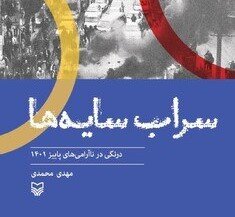West waiting for the perfect moment to pull the trigger on Iran

TEHRAN – In chapter 3 of the ‘Mirage of Shadows’ Mehdi Mohammadi explains how a dossier of evidence collated by Iran’s intelligence forces shows Israel and the West had their finger on the trigger for several years, waiting for the perfect moment to strike Iran and unleash turmoil in the country.
In the previous chapter, Mohammadi elaborated on how the West had been able to identify potential “soldiers” among different groups of Iranian civilians and groom them for the time they would have to take to the streets and create unrest under the banner of “freedom” and “democracy”.
The West needed to create the grounds for a total explosion to put this small but trained group of future rioters to use. For that, it assembled different anti-Iranian and so-called “opposition” members in a meeting attended by high-ranking American, European, Israeli, and certain Arab officials.
The meeting, held in Tel Aviv in March of 2022, had gathered individuals from different groups of Iranians; heads of Western-based media outlets, self-proclaimed defenders of human rights, and even terror outfits that have killed thousands of people in the past decades. The participants were told that Israel had assumed command of all Western initiatives dedicated to toppling the Iranian government and that it is looking to form a collaborative framework with all anti-Iranian factions to get ready for an imminent "crucial opportunity.”
Another audio file belonging to Iranian monarchists residing abroad revealed that the West had come up with a comprehensive plan that would lead to the overthrow of the Iranian government by the beginning of 2023. According to the file recorded months before the riots, after the assassination of a top Iranian military general and a sabotage attack at a military base in Esfahan, protests would take over Iranian cities in September of 2022. These demonstrations will snowball into an armed struggle and eventually lead to the downfall of the Islamic Republic by January.
Mahsa Amini's passing served as the long-awaited catalyst sought by Israel and the West to incite widespread unrest within Iran. To ensure the mobilization of a substantial portion of the Iranian population, meticulous consideration was given to selecting the prime instigators and target demographics for the ensuing turmoil.
Israel and the West particularly aimed to influence three key groups within the Iranian populace: Women, celebrities and influencers, and Generation Z.
Recognizing the diverse segments within Iranian society, the strategy entailed using women's narratives to invoke a collective sense of moral duty, leveraging the prevailing view of women experiencing “oppression” in Iran. By tapping into an incident that supposedly highlighted the plight of “oppressed Iranian women”, the agitators sought to compel bystanders to join the unrest and show “support” for their fellow female compatriots.
Celebrities and influencers were strategically employed as agents of amplification and propaganda. With large audiences and persuasive capabilities, they were integral to disseminating information about the perceived "atrocities" inflicted upon Iranian women. Investigations have since revealed that while some influencers did align with Western spy agencies, the majority felt coerced to engage in the discourse out of fear of losing their popularity.
It is important to note that between September 16 and the same day in October, at least 50,000 accounts seemingly belonging to Iranian users joined Twitter. further scrutiny revealed that these accounts were predominantly managed from the occupied Palestinian territories. These fabricated profiles were tasked with launching attacks and denunciations against public figures who chose to remain silent on the matter and refrain from stoking the flames of unrest.
The most immediate focus for the West was on influencing Gen Z, individuals aged between 18 and 24, who were deemed susceptible to manipulation by intelligence agencies. The architects behind the 2022 unrest believed that it would be relatively easy to present a distorted version of reality to Gen Z through social media and make them engage in risky and destructive behavior. Interrogations of young rioters in custody revealed a lack of full comprehension regarding the gravity of their actions. Many were under the impression that they were partaking in a "revolution" and viewed themselves as heroes in the unfolding events. To them, the acts of vandalism against buildings, vehicles, and infrastructure seemed akin to a thrilling movie rather than deeds with potentially severe repercussions. While the bigger presence of Generation Z participants in the 2022 riots compared to other age groups showcased their susceptibility to influence, it also highlighted their proclivity for swiftly disengaging and reverting to normalcy upon grasping the implications of their actions. This group was easily swayed but lacked enduring strategic impact.
The Iranian judiciary, quickly realizing that the majority of Gen Z’ers had been influenced by a massive propaganda campaign, proceeded to release most of the young detainees that had laid physical waste to their towns.
To be continued…
Leave a Comment